myCBSEguide
- Mathematics
- CBSE Class 9 Mathematics...

CBSE Class 9 Mathematics Case Study Questions
Table of Contents
myCBSEguide App
Download the app to get CBSE Sample Papers 2023-24, NCERT Solutions (Revised), Most Important Questions, Previous Year Question Bank, Mock Tests, and Detailed Notes.
If you’re looking for a comprehensive and reliable study resource and case study questions for class 9 CBSE, myCBSEguide is the perfect door to enter. With over 10,000 study notes, solved sample papers and practice questions, it’s got everything you need to ace your exams. Plus, it’s updated regularly to keep you aligned with the latest CBSE syllabus . So why wait? Start your journey to success with myCBSEguide today!
Significance of Mathematics in Class 9
Mathematics is an important subject for students of all ages. It helps students to develop problem-solving and critical-thinking skills, and to think logically and creatively. In addition, mathematics is essential for understanding and using many other subjects, such as science, engineering, and finance.
CBSE Class 9 is an important year for students, as it is the foundation year for the Class 10 board exams. In Class 9, students learn many important concepts in mathematics that will help them to succeed in their board exams and in their future studies. Therefore, it is essential for students to understand and master the concepts taught in Class 9 Mathematics .
Case studies in Class 9 Mathematics
A case study in mathematics is a detailed analysis of a particular mathematical problem or situation. Case studies are often used to examine the relationship between theory and practice, and to explore the connections between different areas of mathematics. Often, a case study will focus on a single problem or situation and will use a variety of methods to examine it. These methods may include algebraic, geometric, and/or statistical analysis.
Example of Case study questions in Class 9 Mathematics
The Central Board of Secondary Education (CBSE) has included case study questions in the Class 9 Mathematics paper. This means that Class 9 Mathematics students will have to solve questions based on real-life scenarios. This is a departure from the usual theoretical questions that are asked in Class 9 Mathematics exams.
The following are some examples of case study questions from Class 9 Mathematics:
Class 9 Mathematics Case study question 1
There is a square park ABCD in the middle of Saket colony in Delhi. Four children Deepak, Ashok, Arjun and Deepa went to play with their balls. The colour of the ball of Ashok, Deepak, Arjun and Deepa are red, blue, yellow and green respectively. All four children roll their ball from centre point O in the direction of XOY, X’OY, X’OY’ and XOY’ . Their balls stopped as shown in the above image.
Answer the following questions:
Answer Key:
Class 9 Mathematics Case study question 2
- Now he told Raju to draw another line CD as in the figure
- The teacher told Ajay to mark ∠ AOD as 2z
- Suraj was told to mark ∠ AOC as 4y
- Clive Made and angle ∠ COE = 60°
- Peter marked ∠ BOE and ∠ BOD as y and x respectively
Now answer the following questions:
- 2y + z = 90°
- 2y + z = 180°
- 4y + 2z = 120°
- (a) 2y + z = 90°
Class 9 Mathematics Case study question 3
- (a) 31.6 m²
- (c) 513.3 m³
- (b) 422.4 m²
Class 9 Mathematics Case study question 4
How to Answer Class 9 Mathematics Case study questions
To crack case study questions, Class 9 Mathematics students need to apply their mathematical knowledge to real-life situations. They should first read the question carefully and identify the key information. They should then identify the relevant mathematical concepts that can be applied to solve the question. Once they have done this, they can start solving the Class 9 Mathematics case study question.
Students need to be careful while solving the Class 9 Mathematics case study questions. They should not make any assumptions and should always check their answers. If they are stuck on a question, they should take a break and come back to it later. With some practice, the Class 9 Mathematics students will be able to crack case study questions with ease.
Class 9 Mathematics Curriculum at Glance
At the secondary level, the curriculum focuses on improving students’ ability to use Mathematics to solve real-world problems and to study the subject as a separate discipline. Students are expected to learn how to solve issues using algebraic approaches and how to apply their understanding of simple trigonometry to height and distance problems. Experimenting with numbers and geometric forms, making hypotheses, and validating them with more observations are all part of Math learning at this level.
The suggested curriculum covers number systems, algebra, geometry, trigonometry, mensuration, statistics, graphing, and coordinate geometry, among other topics. Math should be taught through activities that include the use of concrete materials, models, patterns, charts, photographs, posters, and other visual aids.
CBSE Class 9 Mathematics (Code No. 041)
| I | NUMBER SYSTEMS | 10 |
| II | ALGEBRA | 20 |
| III | COORDINATE GEOMETRY | 04 |
| IV | GEOMETRY | 27 |
| V | MENSURATION | 13 |
| VI | STATISTICS & PROBABILITY | 06 |
Class 9 Mathematics question paper design
The CBSE Class 9 mathematics question paper design is intended to measure students’ grasp of the subject’s fundamental ideas. The paper will put their problem-solving and analytical skills to the test. Class 9 mathematics students are advised to go through the question paper pattern thoroughly before they start preparing for their examinations. This will help them understand the paper better and enable them to score maximum marks. Refer to the given Class 9 Mathematics question paper design.
QUESTION PAPER DESIGN (CLASS 9 MATHEMATICS)
| 1. | Exhibit memory of previously learned material by recalling facts, terms, basic concepts, and answers. Demonstrate understanding of facts and ideas by organizing, comparing, translating, interpreting, giving descriptions, and stating main ideas | 43 | 54 |
| 2. | Solve problems to new situations by applying acquired knowledge, facts, techniques and rules in a different way. | 19 | 24 |
| 3. | Examine and break information into parts by identifying motives or causes. Make inferences and find evidence to support generalizations Present and defend opinions by making judgments about information, validity of ideas, or quality of work based on a set of criteria. Compile information together in a different way by combining elements in a new pattern or proposing alternative solutions | 18 | 22 |
| 80 | 100 |
myCBSEguide: Blessing in disguise
Class 9 is an important milestone in a student’s life. It is the last year of high school and the last chance to score well in the CBSE board exams. myCBSEguide is the perfect platform for students to get started on their preparations for Class 9 Mathematics. myCBSEguide provides comprehensive study material for all subjects, including practice questions, sample papers, case study questions and mock tests. It also offers tips and tricks on how to score well in exams. myCBSEguide is the perfect door to enter for class 9 CBSE preparations.
Test Generator
Create question paper PDF and online tests with your own name & logo in minutes.
Question Bank, Mock Tests, Exam Papers, NCERT Solutions, Sample Papers, Notes
Related Posts
- Competency Based Learning in CBSE Schools
- Class 11 Physical Education Case Study Questions
- Class 11 Sociology Case Study Questions
- Class 12 Applied Mathematics Case Study Questions
- Class 11 Applied Mathematics Case Study Questions
- Class 11 Mathematics Case Study Questions
- Class 11 Biology Case Study Questions
- Class 12 Physical Education Case Study Questions
14 thoughts on “CBSE Class 9 Mathematics Case Study Questions”
This method is not easy for me
aarti and rashika are two classmates. due to exams approaching in some days both decided to study together. during revision hour both find difficulties and they solved each other’s problems. aarti explains simplification of 2+ ?2 by rationalising the denominator and rashika explains 4+ ?2 simplification of (v10-?5)(v10+ ?5) by using the identity (a – b)(a+b). based on above information, answer the following questions: 1) what is the rationalising factor of the denominator of 2+ ?2 a) 2-?2 b) 2?2 c) 2+ ?2 by rationalising the denominator of aarti got the answer d) a) 4+3?2 b) 3+?2 c) 3-?2 4+ ?2 2+ ?2 d) 2-?3 the identity applied to solve (?10-?5) (v10+ ?5) is a) (a+b)(a – b) = (a – b)² c) (a – b)(a+b) = a² – b² d) (a-b)(a+b)=2(a² + b²) ii) b) (a+b)(a – b) = (a + b
MATHS PAAGAL HAI
All questions was easy but search ? hard questions. These questions was not comparable with cbse. It was totally wastage of time.
Where is search ? bar
maths is love
Can I have more questions without downloading the app.
I love math
Hello l am Devanshu chahal and l am an entorpinior. I am started my card bord business and remanded all the existing things this all possible by math now my business is 120 crore and my business profit is 25 crore in a month. l find the worker team because my business is going well Thanks
Leave a Comment
Save my name, email, and website in this browser for the next time I comment.
CBSE Case Study Questions for Class 9 Maths - Pdf PDF Download
| 1 Crore+ students have signed up on EduRev. Have you? |
CBSE Case Study Questions for Class 9 Maths
CBSE Case Study Questions for Class 9 Maths are a type of assessment where students are given a real-world scenario or situation and they need to apply mathematical concepts to solve the problem. These types of questions help students to develop their problem-solving skills and apply their knowledge of mathematics to real-life situations.
Chapter Wise Case Based Questions for Class 9 Maths
The CBSE Class 9 Case Based Questions can be accessed from Chapetrwise Links provided below:
Chapter-wise case-based questions for Class 9 Maths are a set of questions based on specific chapters or topics covered in the maths textbook. These questions are designed to help students apply their understanding of mathematical concepts to real-world situations and events.
Chapter 1: Number System
- Case Based Questions: Number System
Chapter 2: Polynomial
- Case Based Questions: Polynomial
Chapter 3: Coordinate Geometry
- Case Based Questions: Coordinate Geometry
Chapter 4: Linear Equations
- Case Based Questions: Linear Equations - 1
- Case Based Questions: Linear Equations -2
Chapter 5: Introduction to Euclid’s Geometry
- Case Based Questions: Lines and Angles
Chapter 7: Triangles
- Case Based Questions: Triangles
Chapter 8: Quadrilaterals
- Case Based Questions: Quadrilaterals - 1
- Case Based Questions: Quadrilaterals - 2
Chapter 9: Areas of Parallelograms
- Case Based Questions: Circles
Chapter 11: Constructions
- Case Based Questions: Constructions
Chapter 12: Heron’s Formula
- Case Based Questions: Heron’s Formula
Chapter 13: Surface Areas and Volumes
- Case Based Questions: Surface Areas and Volumes
Chapter 14: Statistics
- Case Based Questions: Statistics
Chapter 15: Probability
- Case Based Questions: Probability
Weightage of Case Based Questions in Class 9 Maths
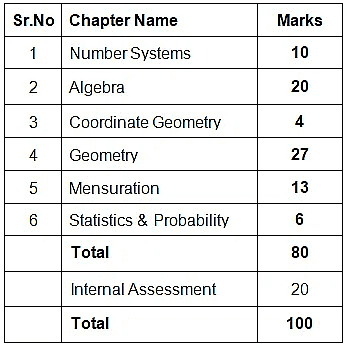
Why are Case Study Questions important in Maths Class 9?
- Enhance critical thinking: Case study questions require students to analyze a real-life scenario and think critically to identify the problem and come up with possible solutions. This enhances their critical thinking and problem-solving skills.
- Apply theoretical concepts: Case study questions allow students to apply theoretical concepts that they have learned in the classroom to real-life situations. This helps them to understand the practical application of the concepts and reinforces their learning.
- Develop decision-making skills: Case study questions challenge students to make decisions based on the information provided in the scenario. This helps them to develop their decision-making skills and learn how to make informed decisions.
- Improve communication skills: Case study questions often require students to present their findings and recommendations in written or oral form. This helps them to improve their communication skills and learn how to present their ideas effectively.
- Enhance teamwork skills: Case study questions can also be done in groups, which helps students to develop teamwork skills and learn how to work collaboratively to solve problems.
In summary, case study questions are important in Class 9 because they enhance critical thinking, apply theoretical concepts, develop decision-making skills, improve communication skills, and enhance teamwork skills. They provide a practical and engaging way for students to learn and apply their knowledge and skills to real-life situations.
Class 9 Maths Curriculum at Glance
The Class 9 Maths curriculum in India covers a wide range of topics and concepts. Here is a brief overview of the Maths curriculum at a glance:
- Number Systems: Students learn about the real number system, irrational numbers, rational numbers, decimal representation of rational numbers, and their properties.
- Algebra: The Algebra section includes topics such as polynomials, linear equations in two variables, quadratic equations, and their solutions.
- Coordinate Geometry: Students learn about the coordinate plane, distance formula, section formula, and slope of a line.
- Geometry: This section includes topics such as Euclid’s geometry, lines and angles, triangles, and circles.
- Trigonometry: Students learn about trigonometric ratios, trigonometric identities, and their applications.
- Mensuration: This section includes topics such as area, volume, surface area, and their applications.
- Statistics and Probability: Students learn about measures of central tendency, graphical representation of data, and probability.
The Class 9 Maths curriculum is designed to provide a strong foundation in mathematics and prepare students for higher education in the field. The curriculum is structured to develop critical thinking, problem-solving, and analytical skills, and to promote the application of mathematical concepts in real-life situations. The curriculum is also designed to help students prepare for competitive exams and develop a strong mathematical base for future academic and professional pursuits.
Students can also access Case Based Questions of all subjects of CBSE Class 9
- Case Based Questions for Class 9 Science
- Case Based Questions for Class 9 Social Science
- Case Based Questions for Class 9 English
- Case Based Questions for Class 9 Hindi
- Case Based Questions for Class 9 Sanskrit
Frequently Asked Questions (FAQs) on Case Based Questions for Class 9 Maths
What is case-based questions.
Case-Based Questions (CBQs) are open-ended problem solving tasks that require students to draw upon their knowledge of Maths concepts and processes to solve a novel problem. CBQs are often used as formative or summative assessments, as they can provide insights into how students reason through and apply mathematical principles in real-world problems.
What are case-based questions in Maths?
Case-based questions in Maths are problem-solving tasks that require students to apply their mathematical knowledge and skills to real-world situations or scenarios.
What are some common types of case-based questions in class 9 Maths?
Common types of case-based questions in class 9 Maths include word problems, real-world scenarios, and mathematical modeling tasks.
Top Courses for Class 9
FAQs on CBSE Case Study Questions for Class 9 Maths - Pdf
| 1. What are case study questions in CBSE Class 9 Maths? |
| 2. How are case study questions different from regular math questions in Class 9? |
| 3. Why are case study questions important in Class 9 Maths? |
| 4. How much weightage do case study questions have in the Class 9 Maths exam? |
| 5. Can you provide some tips to effectively answer case study questions in Class 9 Maths? |
| Views | |
| Rating | |
Sample Paper
Extra questions, cbse case study questions for class 9 maths - pdf, important questions, mock tests for examination, study material, video lectures, practice quizzes, semester notes, previous year questions with solutions, objective type questions, viva questions, shortcuts and tricks, past year papers.

CBSE Case Study Questions for Class 9 Maths - Pdf Free PDF Download
Importance of cbse case study questions for class 9 maths - pdf, cbse case study questions for class 9 maths - pdf notes, cbse case study questions for class 9 maths - pdf class 9, study cbse case study questions for class 9 maths - pdf on the app.
| cation olution |
| Join the 10M+ students on EduRev |
Welcome Back
Create your account for free.

Forgot Password
Unattempted tests, change country, practice & revise.

- Andhra Pradesh
- Chhattisgarh
- West Bengal
- Madhya Pradesh
- Maharashtra
- Jammu & Kashmir
- NCERT Books 2022-23
- NCERT Solutions
- NCERT Notes
- NCERT Exemplar Books
- NCERT Exemplar Solution
- States UT Book
- School Kits & Lab Manual
- NCERT Books 2021-22
- NCERT Books 2020-21
- NCERT Book 2019-2020
- NCERT Book 2015-2016
- RD Sharma Solution
- TS Grewal Solution
- TR Jain Solution
- Selina Solution
- Frank Solution
- Lakhmir Singh and Manjit Kaur Solution
- I.E.Irodov solutions
- ICSE - Goyal Brothers Park
- ICSE - Dorothy M. Noronhe
- Sandeep Garg Textbook Solution
- Micheal Vaz Solution
- S.S. Krotov Solution
- Evergreen Science
- KC Sinha Solution
- ICSE - ISC Jayanti Sengupta, Oxford
- ICSE Focus on History
- ICSE GeoGraphy Voyage
- ICSE Hindi Solution
- ICSE Treasure Trove Solution
- Thomas & Finney Solution
- SL Loney Solution
- SB Mathur Solution
- P Bahadur Solution
- Narendra Awasthi Solution
- MS Chauhan Solution
- LA Sena Solution
- Integral Calculus Amit Agarwal Solution
- IA Maron Solution
- Hall & Knight Solution
- Errorless Solution
- Pradeep's KL Gogia Solution
- OP Tandon Solutions
- Sample Papers
- Previous Year Question Paper
- Important Question
- Value Based Questions
- CBSE Syllabus
- CBSE MCQs PDF
- Assertion & Reason
- New Revision Notes
- Revision Notes
- Question Bank
- Marks Wise Question
- Toppers Answer Sheets
- Exam Paper Aalysis
- Concept Map
- CBSE Text Book
- Additional Practice Questions
- Vocational Book
- CBSE - Concept
- KVS NCERT CBSE Worksheets
- Formula Class Wise
- Formula Chapter Wise
- JEE Previous Year Paper
- JEE Mock Test
- JEE Crash Course
- JEE Sample Papers
- Important Info
- SRM-JEEE Previous Year Paper
- SRM-JEEE Mock Test
- VITEEE Previous Year Paper
- VITEEE Mock Test
- BITSAT Previous Year Paper
- BITSAT Mock Test
- Manipal Previous Year Paper
- Manipal Engineering Mock Test
- AP EAMCET Previous Year Paper
- AP EAMCET Mock Test
- COMEDK Previous Year Paper
- COMEDK Mock Test
- GUJCET Previous Year Paper
- GUJCET Mock Test
- KCET Previous Year Paper
- KCET Mock Test
- KEAM Previous Year Paper
- KEAM Mock Test
- MHT CET Previous Year Paper
- MHT CET Mock Test
- TS EAMCET Previous Year Paper
- TS EAMCET Mock Test
- WBJEE Previous Year Paper
- WBJEE Mock Test
- AMU Previous Year Paper
- AMU Mock Test
- CUSAT Previous Year Paper
- CUSAT Mock Test
- AEEE Previous Year Paper
- AEEE Mock Test
- UPSEE Previous Year Paper
- UPSEE Mock Test
- CGPET Previous Year Paper
- Crash Course
- Previous Year Paper
- NCERT Based Short Notes
- NCERT Based Tests
- NEET Sample Paper
- Previous Year Papers
- Quantitative Aptitude
- Numerical Aptitude Data Interpretation
- General Knowledge
- Mathematics
- Agriculture
- Accountancy
- Business Studies
- Political science
- Enviromental Studies
- Mass Media Communication
- Teaching Aptitude
- NAVODAYA VIDYALAYA
- SAINIK SCHOOL (AISSEE)
- Mechanical Engineering
- Electrical Engineering
- Electronics & Communication Engineering
- Civil Engineering
- Computer Science Engineering
- CBSE Board News
- Scholarship Olympiad
- School Admissions
- Entrance Exams
- All Board Updates
- Miscellaneous
- State Wise Books
- Engineering Exam
CBSE Class 9th Maths 2023 : 30 Most Important Case Study Questions with Answers; Download PDF

SHARING IS CARING If our Website helped you a little, then kindly spread our voice using Social Networks. Spread our word to your readers, friends, teachers, students & all those close ones who deserve to know what you know now.
CBSE Class 9 Maths exam 2022-23 will have a set of questions based on case studies in the form of MCQs. CBSE Class 9 Maths Question Bank on Case Studies given in this article can be very helpful in understanding the new format of questions.
Each question has five sub-questions, each followed by four options and one correct answer. Students can easily download these questions in PDF format and refer to them for exam preparation.
| Case Study Questions - 1 | |
| Case Study Questions - 2 | |
| Case Study Questions - 3 | |
| Case Study Questions - 4 | |
| Case Study Questions - 5 | |
| Case Study Questions - 6 | |
| Case Study Questions - 7 | |
| Case Study Questions - 8 | |
| Case Study Questions - 9 | |
| Case Study Questions - 10 | |
| Case Study Questions - 11 | |
| Case Study Questions - 12 | |
| Case Study Questions - 13 | |
| Case Study Questions - 14 | |
| Case Study Questions - 15 | |
| Case Study Questions - 16 | |
| Case Study Questions - 17 | |
| Case Study Questions - 18 | |
| Case Study Questions - 19 | |
| Case Study Questions - 20 | |
| Case Study Questions - 21 | |
| Case Study Questions - 22 | |
| Case Study Questions - 23 | |
| Case Study Questions - 24 | |
| Case Study Questions - 25 | |
| Case Study Questions - 26 | |
| Case Study Questions - 27 | |
| Case Study Questions - 28 | |
| Case Study Questions - 29 | |
| Case Study Questions - 30 |
CBSE Class 9 All Students can also Download here Class 9 Other Study Materials in PDF Format.

- NCERT Solutions for Class 12 Maths
- NCERT Solutions for Class 10 Maths
- CBSE Syllabus 2023-24
- Social Media Channels
- Login Customize Your Notification Preferences
- CBSE Class 9th 2023-24 : Science Practical Syllabus; Download PDF 19 April, 2023, 4:52 pm
- CBSE Class 9 Maths Practice Book 2023 (Released By CBSE) 23 March, 2023, 6:16 pm
- CBSE Class 9 Science Practice Book 2023 (Released By CBSE) 23 March, 2023, 5:56 pm
- CBSE Class 9th Maths 2023 : 30 Most Important Case Study Questions with Answers; Download PDF 10 February, 2023, 6:20 pm
- CBSE Class 9th Maths 2023 : Important Assertion Reason Question with Solution Download Pdf 9 February, 2023, 12:16 pm
- CBSE Class 9th Exam 2023 : Social Science Most Important Short Notes; Download PDF 16 January, 2023, 4:29 pm
- CBSE Class 9th Mathematics 2023 : Most Important Short Notes with Solutions 27 December, 2022, 6:05 pm
- CBSE Class 9th English 2023 : Chapter-wise Competency-Based Test Items with Answer; Download PDF 21 December, 2022, 5:16 pm
- CBSE Class 9th Science 2023 : Chapter-wise Competency-Based Test Items with Answers; Download PDF 20 December, 2022, 5:37 pm

- Second click on the toggle icon

Provide prime members with unlimited access to all study materials in PDF format.
Allow prime members to attempt MCQ tests multiple times to enhance their learning and understanding.
Provide prime users with access to exclusive PDF study materials that are not available to regular users.

- Skip to main content
- Skip to secondary menu
- Skip to primary sidebar
- Skip to footer
Learn Insta
RD Sharma Solutions , RS Aggarwal Solutions and NCERT Solutions
Heron’s Formula Class 9 Extra Questions Maths Chapter 12 with Solutions Answers
May 28, 2022 by Prasanna
Here we are providing Heron’s Formula Class 9 Extra Questions Maths Chapter 12 with Answers Solutions, Extra Questions for Class 9 Maths was designed by subject expert teachers.
Extra Questions for Class 9 Maths Heron’s Formula with Answers Solutions
Extra Questions for Class 9 Maths Chapter 12 Heron’s Formula with Solutions Answers

Heron’s Formula Class 9 Extra Questions Very Short Answer Type
Question 1. Find the area of an equilateral triangle having side 6 cm. Solutioin: Area of an equilateral triangle = \(\frac{\sqrt{3}}{4}\) × (side) 2 = \(\frac{\sqrt{3}}{4}\) × 6 × 6 = 9√3 cm 2

Heron’s Formula Class 9 Extra Questions Short Answer Type 2
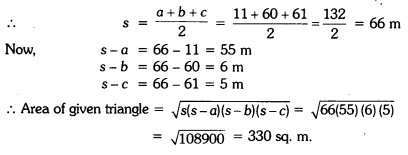
CBSE Class 10 Maths Formulas for Chapter 4 Quadratic Equations are mentioned in this article.
Heron’s Formula Class 9 Extra Questions Long Answer Type
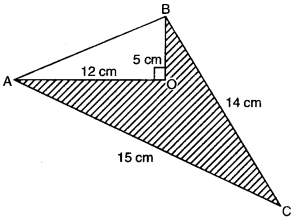
Heron’s Formula Class 9 Extra Questions HOTS
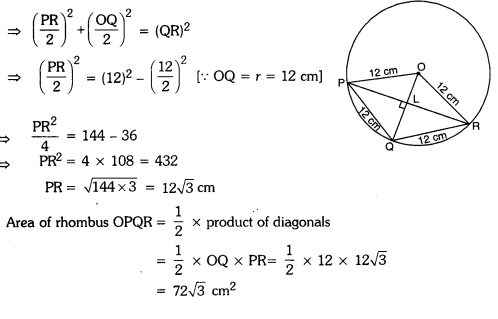
Now, area of orange shaded paper in kite = Area of ∆AOD + Area of ∆CEF = 450 cm 2 + 198.4 cm 2 = 648.4 cm 2 Area of blue shaded paper in kite = Area of ∆AOB + Area of ∆COD = 450 cm 2 + 450 cm 2 = 900 cm 2 Area of black shaded paper in kite = Area of ∆BOC = 450 cm 2 .
Heron’s Formula Class 9 Extra Questions Value Based (VBQs)
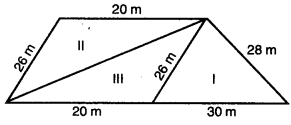
NCERT Solutions for Class 9 Maths Chapter 12 Heron’s Formula
NCERT Solutions for Class 9 Maths Chapter 12 Heron’s Formula are provided here. Our NCERT Maths solutions contain all the questions of the NCERT textbook that are solved and explained beautifully. Here you will get complete NCERT Solutions for Class 9 Maths Chapter 12 all exercises Exercise in one place. These solutions are prepared by the subject experts and as per the latest NCERT syllabus and guidelines. CBSE Class 9 Students who wish to score good marks in the maths exam must practice these questions regularly.
Class 9 Maths Chapter 12 Heron’s Formula NCERT Solutions
Below we have provided the solutions of each exercise of the chapter. Go through the links to access the solutions of exercises you want. You should also check out our NCERT Class 9 Solutions for other subjects to score good marks in the exams.
NCERT Solutions for Class 9 Maths Chapter 12 Exercise 12.1
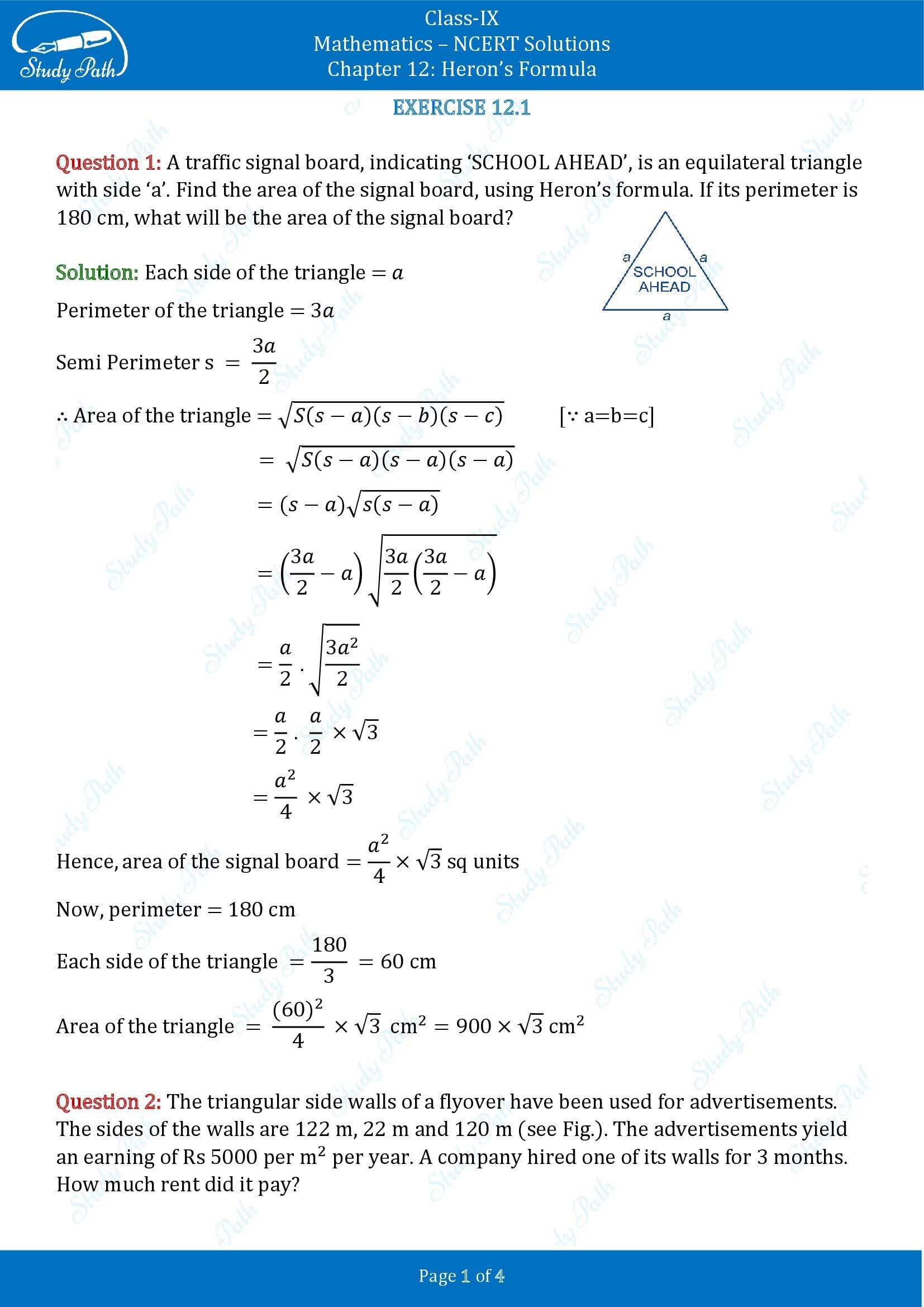
NCERT Solutions for Class 9 Maths Chapter 12 Exercise 12.2
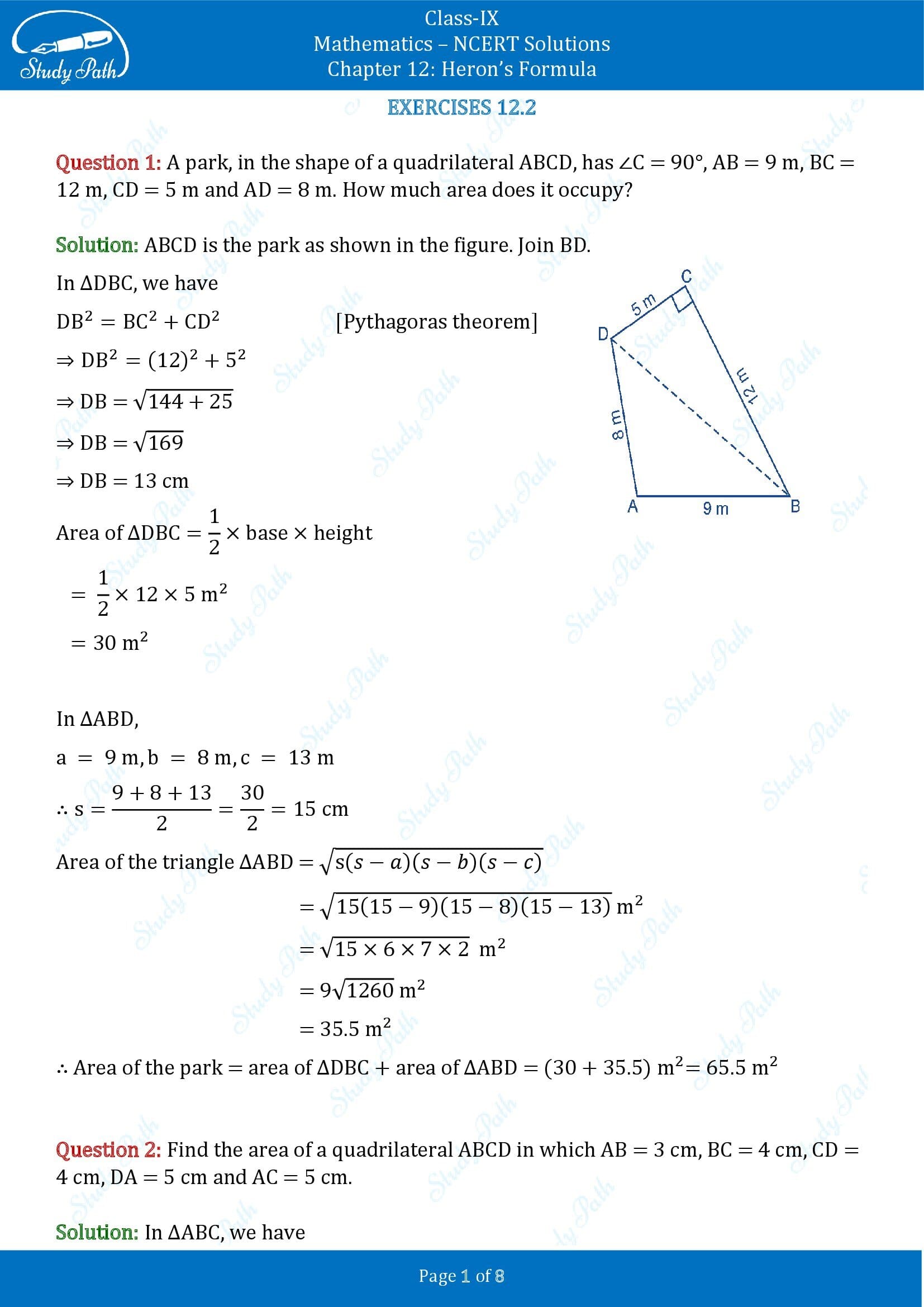
NCERT Solutions for Class 9 Maths Chapter 12 – Topic Discussion
Below we have listed the topics that have been discussed in this chapter.
- Heron’s Formula
Leave a Reply Cancel reply
Your email address will not be published. Required fields are marked *
Save my name, email, and website in this browser for the next time I comment.

(Education-Your Door To The Future)
CBSE Class 9 Maths Most Important Case Study Based Questions With Solution
Cbse class 9 mathematics case study questions.
In this post I have provided CBSE Class 9 Maths Case Study Based Questions With Solution. These questions are very important for those students who are preparing for their final class 9 maths exam.
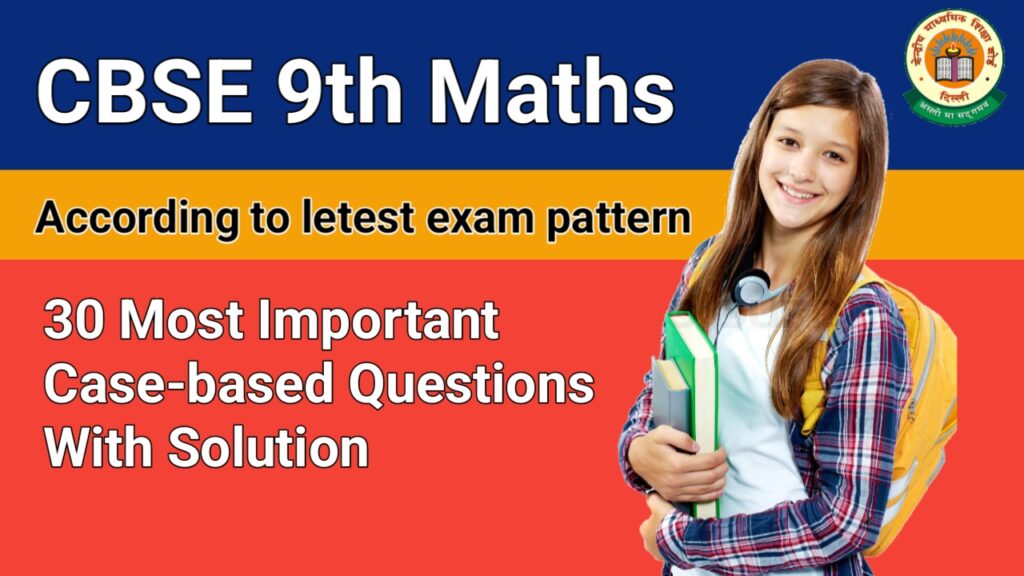
All these questions provided in this article are with solution which will help students for solving the problems. Dear students need to practice all these questions carefully with the help of given solutions.
As you know CBSE Class 9 Maths exam will have a set of cased study based questions in the form of MCQs. CBSE Class 9 Maths Question Bank given in this article can be very helpful in understanding the new format of questions for new session.
All Of You Can Also Read
Case studies in class 9 mathematics.
The Central Board of Secondary Education (CBSE) has included case study based questions in the Class 9 Mathematics paper in current session. According to new pattern CBSE Class 9 Mathematics students will have to solve case based questions. This is a departure from the usual theoretical conceptual questions that are asked in Class 9 Maths exam in this year.
Each question provided in this post has five sub-questions, each followed by four options and one correct answer. All CBSE Class 9th Maths Students can easily download these questions in PDF form with the help of given download Links and refer for exam preparation.
There is many more free study materials are available at Maths And Physics With Pandey Sir website. For many more books and free study material all of you can visit at this website.
Given Below Are CBSE Class 9th Maths Case Based Questions With Their Respective Download Links.
| Case-based Questions – 1 | |
| Case-based Questions – 2 | |
| Case-based Questions – 3 | |
| Case-based Questions – 4 | |
| Case-based Questions – 5 | |
| Case-based Questions – 6 | |
| Case-based Questions – 7 | |
| Case-based Questions – 8 | |
| Case-based Questions – 9 | |
| Case-based Questions – 10 | |
| Case-based Questions – 11 | |
| Case-based Questions – 12 | |
| Case-based Questions – 13 | |
| Case-based Questions – 14 | |
| Case-based Questions – 15 | |
| Case-based Questions – 16 | |
| Case-based Questions – 17 | |
| Case-based Questions – 18 | |
| Case-based Questions – 19 | |
| Case-based Questions – 20 | |
| Case-based Questions – 21 | |
| Case-based Questions – 22 | |
| Case-based Questions – 23 | |
| Case-based Questions – 24 | |
| Case-based Questions – 25 | |
| Case-based Questions – 26 | |
| Case-based Questions – 27 | |
| Case-based Questions – 28 | |
| Case-based Questions – 29 | |
| Case-based Questions – 30 |

Gurukul of Excellence
Classes for Physics, Chemistry and Mathematics by IITians
Category: Case Study Questions for Class 9 Maths
Join our Telegram Channel for Free PDF Download
Case Study Questions for Class 9 Maths Chapter 12 Herons Formula
Case study questions for class 9 maths chapter 9 areas of parallelograms and triangles, case study questions for class 9 maths chapter 6 lines and angles, case study questions for class 9 maths chapter 7 triangles, case study questions for class 9 maths chapter 5 introduction to euclid’s geometry, case study and passage based questions for class 9 maths chapter 14 statistics, case study questions for class 9 maths chapter 1 real numbers, case study questions for class 9 maths chapter 4 linear equations in two variables, case study questions for class 9 maths chapter 3 coordinate geometry, case study questions for class 9 maths chapter 15 probability, case study questions for class 9 maths chapter 13 surface area and volume, case study questions for class 9 maths chapter 10 circles, case study questions for class 9 maths chapter 9 quadrilaterals, case study questions for class 9 maths chapter 2 polynomials.
Join our Online Test Series for CBSE, ICSE, JEE, NEET and Other Exams

Editable Study Materials for Your Institute - CBSE, ICSE, State Boards (Maharashtra & Karnataka), JEE, NEET, FOUNDATION, OLYMPIADS, PPTs
NCERT Solutions for Class 6, 7, 8, 9, 10, 11 and 12
NCERT Solutions for Class 9 Maths Chapter 12 Heron’s Formula Ex 12.2
N cert solutions for class 9 maths chapter 12 heron’s formula ex 12.2.
The topics and sub-topics in NCERT Class 9 Maths Text Book Chapter 12 Heron’s Formula:
- Heron’s Formula
- Introduction
- Area Of A Triangle – By Heron’s Formula
- Application Of Heron’s Formula In Finding Areas Of Quadrilaterals
Formulae Handbook for Class 9 Maths and Science Educational Loans in India
- Herons Formula Exercise 12.1
Ex 12.2 Class 9 Maths Question 1
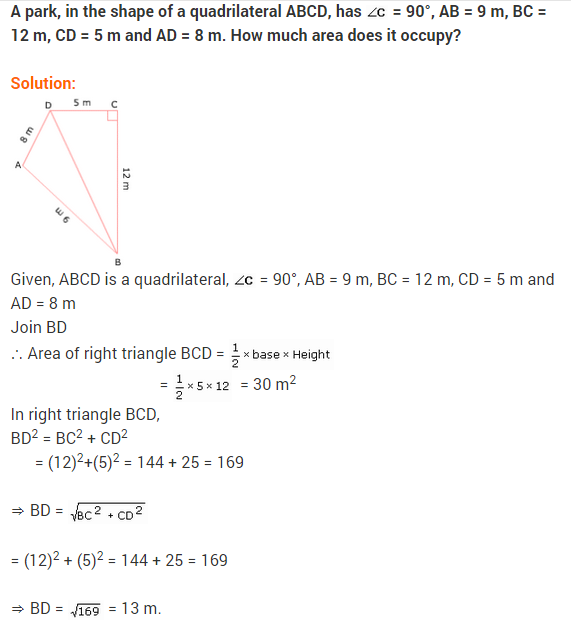
More Resources for CBSE Class 9
NCERT Solutions
- NCERT Solutions Class 9 Maths
- NCERT Solutions Class 9 Science
- NCERT Solutions Class 9 Social Science
- NCERT Solutions Class 9 English
- NCERT Solutions Class 9 Hindi
- NCERT Solutions Class 9 Sanskrit
- NCERT Solutions Class 9 IT
- RD Sharma Class 9 Solutions
Ex 12.2 Class 9 Maths Question 3
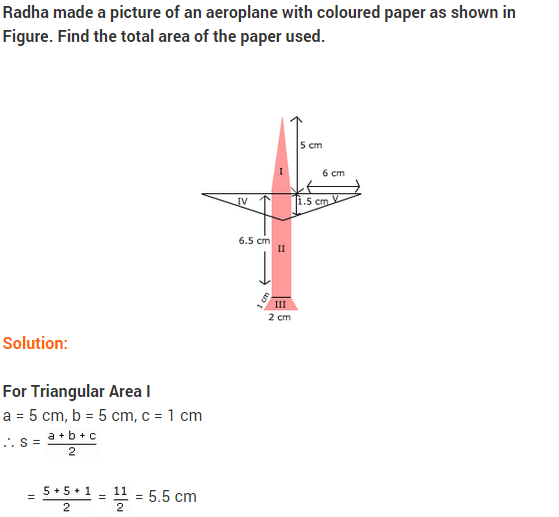
Ex 12.2 Class 9 Maths Question 9
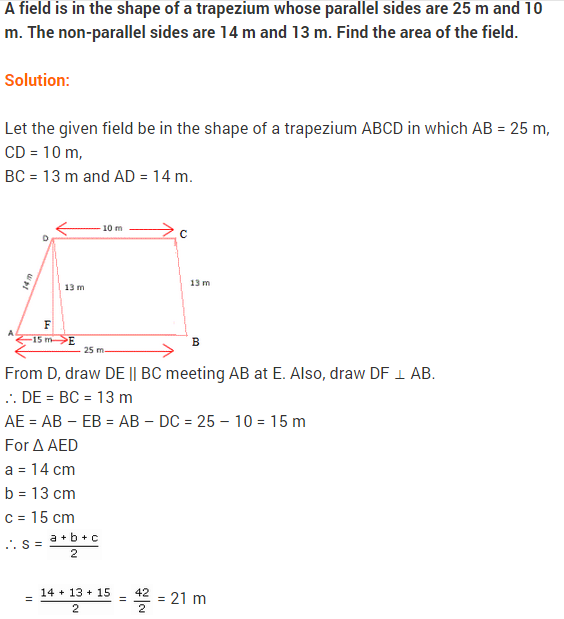
NCERT Solutions for Class 9 Maths Chapter 12 Heron’s Formula (हीरोन सूत्र) (Hindi Medium) Ex 12.2
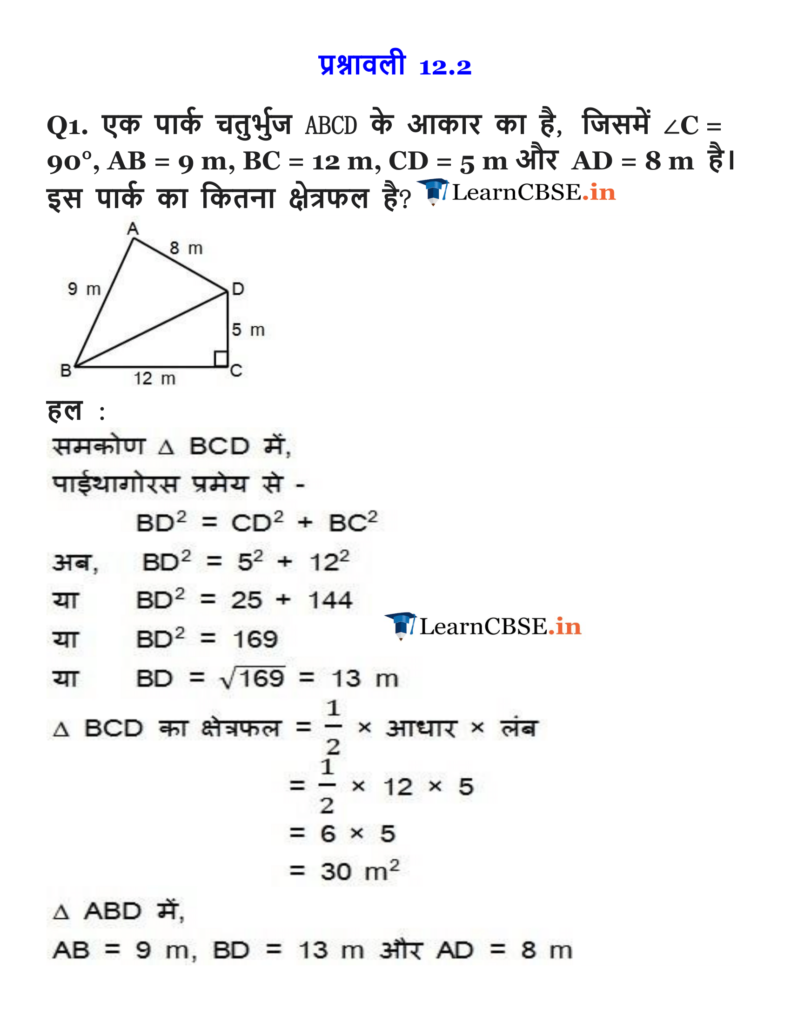
NCERT Solutions for Class 9 Maths
- Chapter 1 Number systems
- Chapter 2 Polynomials
- Chapter 3 Coordinate Geometry
- Chapter 4 Linear Equations in Two Variables
- Chapter 5 Introduction to Euclid Geometry
- Chapter 6 Lines and Angles
- Chapter 7 Triangles
- Chapter 8 Quadrilaterals
- Chapter 9 Areas of Parallelograms and Triangles
- Chapter 10 Circles
- Chapter 11 Constructions
- Chapter 12 Heron’s Formula
- Chapter 13 Surface Areas and Volumes
- Chapter 14 Statistics
- Chapter 15 Probability
- Class 9 Maths (Download PDF)
Free Resources
Quick Resources
Talk to our experts
1800-120-456-456
NCERT Solutions for Class 9 Maths Chapter 10 Heron's Formula
- NCERT Solutions
- Chapter 12 Herons Formula

NCERT Solutions for Maths Chapter 10 Class 9 Heron’s Formula - FREE PDF Download
NCERT Solutions for heron's formula class 9 maths ch 10 Heron’s Formula curated by our subject experts to facilitate a practical and smooth understanding of the concepts related to Heron's Formula. These NCERT Solutions can be accessed anytime and anywhere, at your convenience, to understand the concepts in a better way. These solutions to each exercise question in the PDF are explained using a clear step-by-step method. It acts as an essential tool for you to prepare the chapter quickly and efficiently during exams. You can download and practice these NCERT Solutions for herons formula Class 9 Maths Chapter 10 to thoroughly understand the concepts covered in the chapter.

Glance on Maths Chapter 10 Class 9 - Heron's Formula
This article deals with Heron's Formula, which is a method to calculate the area of a triangle when the lengths of all three sides are known.
The questions cover topics such as finding the area of a triangle when the sides are given, finding the missing side when the area and two sides are given, and finding the height of a triangle when the area and the base are given.
Chapter 10 Maths Class 9 recalls how to calculate the perimeter of various figures and shapes.
This article contains chapter notes, exercises, explanation videos, links, and important questions for Chapter 10 - Heron's Formula where you can download a FREE PDF.
There is one exercise (6 fully solved questions) in class 9th maths chapter 10 Heron's Formula.
Access Exercise Wise NCERT Solutions for Chapter 10 Maths Class 9
S.No. | Current Syllabus Exercises of Class 9 Maths Chapter 10 |
1 |
|

Exercises Under NCERT Solutions for Class 9 Maths Chapter 10 Heron's Formula
Exercise 10.1: This exercise consists of six questions that are based on the concept of Heron's Formula. The questions cover topics such as finding the area of a triangle when the sides are given, finding the missing side when the area and two sides are given, and finding the height of a triangle when the area and the base are given. The exercise also includes word problems that require the application of Heron's Formula to find the area of triangles.
Access NCERT Solutions Maths Chapter 10 - Heron’s formula
Exercise 10.1 .
1. A traffic signal board, indicating ‘SCHOOL AHEAD’, is an equilateral triangle with side $'a'$. Find the area of the signal board, using Heron’s formula. If its perimeter is $180\ \text{cm}$, what will be the area of the signal board?
Length of the side of traffic signal board $=a$
Perimeter of traffic signal board which is an equilateral triangle $=3\times a$
We know that,
$2s=$ Perimeter of the triangle,
So, $2s=3a$
$\Rightarrow s=\dfrac{3}{2}a$
Area of triangle can be evaluated by Heron’s formula:
$A=\sqrt{s\left( s-a \right)\left( s-b \right)\left( s-c \right)}$
$a$ , $b$ and $c$ are the sides of the triangle
\[s=\dfrac{a+b+c}{2}\]
Substituting $s=\dfrac{3}{2}a$ in Heron’s formula, we get:
Area of given triangle:
$A=\sqrt{\dfrac{3}{2}a\left( \dfrac{3}{2}a-a \right)\left( \dfrac{3}{2}a-a \right)\left( \dfrac{3}{2}a-a \right)}$
$A=\dfrac{\sqrt{3}}{2}{{a}^{2}}\ \ ......\text{(1)}$
Perimeter of traffic signal board:
$P=180\ \text{cm}$
Hence, side of traffic signal board
$a=\left( \dfrac{180}{3} \right)$
$a=60\ \ ......\text{(2)}$
Substituting Equation (2) in Equation (1), we get:
Area of traffic signal board is $A=\dfrac{\sqrt{3}}{2}{{\left( 60\,cm \right)}^{2}}$
$\Rightarrow A=\left( \dfrac{3600}{4}\sqrt{3} \right)\,c{{m}^{2}}$
$\Rightarrow A=900\sqrt{3}\,c{{m}^{2}}$
Hence, the area of the signal board is $900\sqrt{3}\text{ c}{{\text{m}}^{2}}$.
2. The triangular side walls of a flyover have been used for advertisements. The sides of the walls are $122m,\,22m,$ and $120m$. The advertisements yield on earning of Rs. $5000\,per\,{{m}^{2}}$ per year. A company hired one of its walls for $3$ months. How much rent did it pay?
Ans: The length of the sides of the triangle are (say $a$, $b$ and $c$)
$a=122\ \text{m}$
$b=22\ \text{m}$
$c=120\ \text{m}$
Perimeter of triangle = sum of the length of all sides
Perimeter of triangle is:
$P=122+22+120$
$P=264\ \text{m}$
$2s=264\ \text{m}$
$s=132\ \text{m}$
Area of triangle can be evaluated by Heron’s formula:
$a$, $b$ and $c$ are the sides of the triangle
So, in this question,
$s=\dfrac{122+22+140}{2}$
Substituting values of $s$ $a$, $b$, $c$ in Heron’s formula, we get:
Area of given triangle $=\left[ \sqrt{132\left( 132-122 \right)\left( 132-22 \right)\left( 132-120 \right)} \right]{{m}^{2}}$
$=\left[ \sqrt{132\left( 10 \right)\left( 110 \right)\left( 12 \right)} \right]\,{{m}^{2}}=1320\,{{m}^{2}}$
It is given that:
Rent of $1{{m}^{2}}$ area per year is:
$R=Rs.\text{ 5000/}{{\text{m}}^{2}}$
Rent of $1{{m}^{2}}$ area per month will be:
$R=Rs.\ \dfrac{5000}{12}/{{m}^{2}}$
Rent of $1320{{m}^{2}}$ area for $3$ months:
$R=\left( \dfrac{5000}{12}\times 3\times 1320 \right)/{{m}^{2}}$
$\Rightarrow R=Rs.\ 1650000$
Therefore, the total cost rent that company must pay is Rs. $1650000$.
3. There is a slide in a park. One of its side walls has been painted in some colour with a message “KEEP THE PARK GREEN AND CLEAN”. If the sides of the wall are 15 m, 11 m and 6 m, find the area painted in colour.
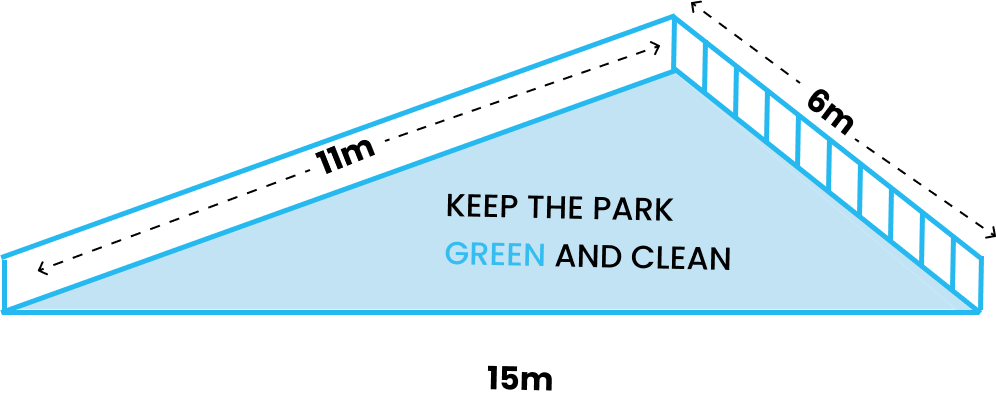
Ans: It is given that the sides of the wall are 15 m, 11 m and 6 m.
So, the semi perimeter of triangular wall (s) = (15+11+6)/2 m = 16 m
Using Heron’s formula,
$A=\sqrt{16(16 - 15)(16 - 11)(16 - 6)}$
$A=\sqrt800 m^2$
$A=20\sqrt2 m^2$
4. Find the area of a triangle two sides of which are $18\mathbf{cm}$ and $10\mathbf{cm}$ and the perimeter is $42cm$.
Ans: Let the length of the third side of the triangle be $x$.
Perimeter of the given triangle:
Let the sides of the triangle be $a$, $b$ and $c$.
Perimeter of the triangle = sum of all sides
$18+10+x=42$
$\Rightarrow 28+x=42$
$\Rightarrow x=14$
$\Rightarrow s=\dfrac{18+10+14}{2}$
$\Rightarrow s=21cm$
Substituting values of $s$ $a$, $b$, $c$ in Heron’s formula, we get:
$A=\left[ \sqrt{21\left( 21-18 \right)\left( 21-10 \right)\left( 21-14 \right)} \right]$
$\Rightarrow A=\left[ \sqrt{21\left( 3 \right)\left( 11 \right)\left( 7 \right)} \right]$
$\Rightarrow A=21\sqrt{11}\text{ }c{{m}^{2}}$
Hence, the area of the given triangle is $21\sqrt{11}\text{ }c{{m}^{2}}$.
5. Sides of a triangle are in the ratio of $12:17:25$ and its perimeter is $540cm$. Find its area.
Ans: Let the common ratio between the sides of the given triangle be $x$.
Therefore, the side of the triangle will be $12x$, $17x$, and $25x$.
It is given that,
Perimeter of this triangle $=540cm$
Perimeter = sum of the length of all sides
$12x+17x+25x=540$
$\Rightarrow 54x=540$
$\Rightarrow x=10$
Sides of the triangle will be:
\[12\times 10=120cm\]
$17\times 10=170cm$
$25\times 10=250cm$
$\Rightarrow s=\dfrac{120+170+250}{2}$
$\Rightarrow s=270cm$
$A=\left[ \sqrt{270\left( 270-120 \right)\left( 270-170 \right)\left( 270-250 \right)} \right]$
$\Rightarrow A=\left[ \sqrt{270\left( 150 \right)\left( 100 \right)\left( 20 \right)} \right]$
$\Rightarrow A=9000c{{m}^{2}}$
Therefore, the area of this triangle is $9000\,c{{m}^{2}}.$
6. An isosceles triangle has perimeter $30cm$ and each of the equal sides is $12cm$. Find the area of the triangle.
Ans: Let the third side of this triangle be $x$.
Measure of equal sides is $12cm$ as the given triangle is an isosceles triangle.
Perimeter of triangle, $P=30cm$
Perimeter of triangle = Sum of the sides
$12+12+x=30$
$\Rightarrow x=6cm$
$\Rightarrow s=\dfrac{12+12+6}{2}$
$\Rightarrow s=15cm$
Substituting values of $s$ $a$, $b$, $c$ in Heron’s formula we get:$A=\left[ \sqrt{15\left( 15-12 \right)\left( 15-12 \right)\left( 15-6 \right)} \right]$
$\Rightarrow A=\left[ \sqrt{15\left( 3 \right)\left( 3 \right)\left( 9 \right)} \right]$
$\Rightarrow A=9\sqrt{15}c{{m}^{2}}$
Hence, the area of the given isosceles triangle is $9\sqrt{15}c{{m}^{2}}$.
Overview of Deleted Syllabus for CBSE Class 9 Maths Heron's Formula
Chapter | Dropped Topics |
Heron’s Formula | 10.1 Introduction |
10.3 Application of Heron’s formula in finding areas of quadrilaterals. |
Class 9 Maths Chapter 10: Exercises Breakdown
Exercise | Number of Questions |
Exercise 10.1 | 6 Questions & Solutions (2 Short Answers, 2 Long Answers, 2 Very Long Answers) |
NCERT Solutions for Class 9 Maths Chapter 10 - Heron's Formula provides a necessary resource for students diving into the world of geometry and trigonometry. In this chapter, students are equipped with Heron's Formula, a powerful method for easily calculating triangle areas. Mastering this chapter not only enhances their understanding of geometry but also improves their problem-solving abilities. Heron's Formula is a valuable addition to their mathematical toolkit, setting a solid foundation for future studies in mathematics and various real-life scenarios where the calculation of triangle areas is essential.
Other Study Material for CBSE Class 9 Maths Chapter 10
S. No. | Important Links for Chapter 10 Circles |
1 |
|
2 |
|
3 |
|
4 |
|
Chapter-Specific NCERT Solutions for Class 9 Maths
Given below are the chapter-wise NCERT Solutions for Class 9 Maths. Go through these chapter-wise solutions to be thoroughly familiar with the concepts.
S.No. | NCERT Solutions Class 9 Chapter-wise Maths PDF |
1 |
|
2 |
|
3 |
|
4 |
|
5 |
|
6 |
|
7 |
|
8 |
|
9 |
|
10 |
|
11 |
|

FAQs on NCERT Solutions for Class 9 Maths Chapter 10 Heron's Formula
1. How to find altitude in Heron's Formula class 9?
In class 9 maths herons formula , Heron's formula itself doesn't directly calculate the altitude of a triangle. However, it can be used along with the concept of area to find the altitude in a scalene triangle (one with all sides unequal). Here's the process:
Heron's formula gives the area (A) of a triangle with sides a, b, and c as:
A = $\sqrt{s(s-a)(s-b)(s-c)}$
where s is the semi-perimeter (s = (a + b + c) / 2)
The area of a triangle can also be calculated as 1/2 * base * height (where base is the side along which the altitude is drawn, and the height is the altitude itself).
By equating these two expressions for area and solving for the height (h) with base (b) known, you can get the formula for altitude using Heron's formula:
h = 2 * $\sqrt{s(s-a)(s-b)(s-c)}$ / b
2. Is Heron's formula applicable for all triangles in chapter 10 class 9 maths solutions pdf?
Yes, In class 9 ch 10 , Heron's formula is applicable to all triangles, irrespective of their type (scalene, isosceles, or equilateral). As long as you know the lengths of all three sides, you can use the formula to find the area of the triangle.
3. What is the real-life application of Heron's formula?
Suppose you have to calculate the area of a triangular land. What is the probability that the area is of a regular shape? It is impossible that you will come across lands with regular spaces and sizes, and this is where Heron’s formula comes into use. To calculate the area of real-life objects, the best way to find the exact area of the land is to use Heron’s formula.
4. What is Heron's formula?
Triangle is a three-dimensional closed shape. Heron’s formula calculates the area of a triangle when the length of all three sides is given. Using Heron's formula, we can calculate the area of any triangle, be it a scalene, isosceles or equilateral triangle. For example, the sides of a triangle are given as a, b, and c. Using Heron’s formula, the area of the triangle can be calculated by Area = √S (S-a)(S-b)(S-c) where s is the semi-perimeter of the triangle.
5. How do you solve Heron's formula questions?
To solve questions based on Heron’s formula, you need to remember Heron’s formula, Area= Area= √S (S-a)(S-b)(S-c). Here, ‘s’ is the semi-perimeter of the triangle, and a, b, and c are the lengths of the sides of the triangle. The semi perimeter is denoted by S. It can be calculated by using the formula: S = a+b+c/2. By substituting the values given in these formulas, you can calculate the area of a triangle.
6. What is the meaning of s in Heron's formula?
In Heron’s formula, Area = √S (S-a)(S-b)(S-c), where ‘s’ stands for the semi-perimeter of the triangle whose area we need to calculate. Semi-perimeter can be calculated by the given formula: S = a+b+c/2. To learn more about the semi-perimeter and its usage in calculating the area of a triangle, you can download the Vedantu app or check out the official website of Vedantu .
7. What is a Semi-Perimeter?
In Geometry, the Semi-perimeter of any polygon is half of its perimeter. In Class 9, Chapter 12, Heron’s Formula explains the semi-perimeter of a triangle. Semi-perimeter is denoted by ‘s’ in Heron’s formula, which is Area= √s (s-a)(s-b)(s-c) ‘s’ stands for semi-perimeter, which can be calculated by the given formula: s = a+b+c/2, where a, b, and c are the sides of the triangle of which the area has to be calculated.
8. What is a Semi-Perimeter?
In Geometry, the Semi-perimeter of any polygon is half of its perimeter. In Class 9, Chapter 12, Heron’s Formula explains the semi-perimeter of a triangle. Semi-perimeter is denoted by ‘s’ in Heron’s formula, which is Area= √s (s-a)(s-b)(s-c)
‘s’ stands for semi-perimeter, which can be calculated by the given formula:
s = a+b+c/2, where a, b and c are the sides of the triangle of which the area has to be calculated.
NCERT Solutions for Class 9 Maths
Ncert solutions for class 9.

Class 9 Maths Case Study Questions of Chapter 1 Real Numbers
- Post author: studyrate
- Post published:
- Post category: class 9th
- Post comments: 0 Comments
Case study Questions in Class 9 Mathematics Chapter 1 are very important to solve for your exam. Class 9 Maths Chapter 1 Case Study Questions have been prepared for the latest exam pattern. You can check your knowledge by solving Class 9 Maths Case Study Questions Chapter 1 Real Numbers
Join our Telegram Channel, there you will get various e-books for CBSE 2024 Boards exams for Class 9th, 10th, 11th, and 12th.

In CBSE Class 9 Maths Paper, Students will have to answer some questions based on Assertion and Reason. There will be a few questions based on case studies and passage-based as well. In that, a paragraph will be given, and then the MCQ questions based on it will be asked.
Real Numbers Case Study Questions With Answers
Here, we have provided case-based/passage-based questions for Class 9 Maths Chapter 1 Real Numbers
Case Study/Passage-Based Questions
Case Study 1: A Mathematics Exhibition is being conducted in your school and one of your friends is making a model of a factor tree. He has some difficulty and asks for your help in completing a quiz for the audience.

Observe the following factor tree and answer the following:
1. What will be the value of x?
Answer: b) 13915
2. What will be the value of y?
Answer: c) 11
3. What will be the value of z?
Answer: b) 23
4. According to the Fundamental Theorem of Arithmetic 13915 is a
a) Composite number
b) Prime number
c) Neither prime nor composite
d) Even number
Answer: a) Composite number
5. The prime factorization of 13915 is
a) 5 × 11 3 × 13 2
b) 5 × 11 3 × 23 2
c) 5 × 11 2 × 23
d) 5 × 11 2 × 13 2
Answer: c) 5 × 112 × 23
Case Study 2: Srikanth has made a project on real numbers, where he finely explained the applicability of exponential laws and divisibility conditions on real numbers. He also included some assessment questions at the end of his project as listed below. Answer them.
(i) For what value of n, 4 n ends in 0?
(a) 10 (b) when n is even (c) when n is odd (d) no value of n
Answer: (d) no value of n3
(ii) If a is a positive rational number and n is a positive integer greater than 1, then for what value of n, an is a rational number?
(a) when n is any even integer (b) when n is any odd integer (c) for all n > 1 (d) only when n=0
Answer: (c) for all n > 1
(iii) If x and y are two odd positive integers, then which of the following is true?
(a) x 2 +y 2 is even (b) x 2 +y 2 is not divisible by 4 (c) x 2 +y 2 is odd (d) both (a) and (b)
Answer: (d) both (a) and (b)
(iv) The statement ‘One of every three consecutive positive integers is divisible by 3’ is
(a) always true (b) always false (c) sometimes true (d) None of these
Answer:(a) always true
(v) If n is any odd integer, then n 2 – 1 is divisible by
(a) 22 (b) 55 (c) 88 (d) 8
Answer: (d) 8
Hope the information shed above regarding Case Study and Passage Based Questions for Class 9 Mathematics Chapter 1 Real Numbers with Answers Pdf free download has been useful to an extent. If you have any other queries about CBSE Class 9 Maths Real Numbers Case Study and Passage Based Questions with Answers, feel free to comment below so that we can revert back to us at the earliest possible By Team Study Rate
You Might Also Like
Class 9 science case study questions chapter 5 the fundamental unit of life, class 9 science case study questions chapter 13 why do we fall ill, ncert science book class 9 in hindi medium | विज्ञान की पुस्तक कक्षा 9 हिंदी, leave a reply cancel reply.
Save my name, email, and website in this browser for the next time I comment.
- NCERT Solutions
- NCERT Class 9
- NCERT 9 Maths
- Chapter 12: Herons Formula
- Exercise 12.1

NCERT Solutions for Class 9 Maths Chapter 12 - Heron's Formula Exercise 12.1
* According to the CBSE Syllabus 2023-24, this chapter has been renumbered as Chapter 10.
NCERT Solutions for Class 9 Maths Chapter 12 – Heron’s Formula Exercise 12.1 helps you understand Heron’s Formula with ease. From an academic perspective, this fundamental concept finds significance in a myriad of areas. Therefore, it is necessary to have a clear grasp of the concept. These solutions are designed by highly knowledgeable teachers with countless years of experience. In other words, NCERT Solutions is one of the best guides for your study needs. Relevant topics are presented in an easy-to-understand format. Moreover, we have barred the use of complex jargon. Furthermore, its content is updated regularly as per the prescribed CBSE syllabus.

Download PDF of NCERT Solutions for Class 9 Maths Chapter 12 – Heron’s Formula Exercise 12.1
carouselExampleControls111

Access other exercise solutions of Class 9 Maths Chapter 12 – Heron’s Formula
Exercise 12.2 Solutions – 9 Questions
Access Answers of Maths NCERT Class 9 Chapter 12 – Heron’s Formula Exercise 12.1
1. A traffic signal board, indicating ‘SCHOOL AHEAD’, is an equilateral triangle with side ‘a’. Find the area of the signal board, using Heron’s formula. If its perimeter is 180 cm, what will be the area of the signal board?
Side of the signal board = a
Perimeter of the signal board = 3a = 180 cm
∴ a = 60 cm
Semi perimeter of the signal board (s) = 3a/2
By using Heron’s formula,
Area of the triangular signal board will be =

2. The triangular side walls of a flyover have been used for advertisements. The sides of the walls are 122 m, 22 m and 120 m (see Fig. 12.9). The advertisements yield an earning of ₹5000 per m 2 per year. A company hired one of its walls for 3 months. How much rent did it pay?

The sides of the triangle ABC are 122 m, 22 m and 120 m respectively.
Now, the perimeter will be (122+22+120) = 264 m
Also, the semi perimeter (s) = 264/2 = 132 m
Using Heron’s formula,
Area of the triangle =

We know that the rent of advertising per year = ₹ 5000 per m 2
∴ The rent of one wall for 3 months = Rs. (1320×5000×3)/12 = Rs. 1650000
3. There is a slide in a park. One of its side walls has been painted in some colour with a message “KEEP THE PARK GREEN AND CLEAN” (see Fig. 12.10 ). If the sides of the wall are 15 m, 11 m and 6 m, find the area painted in colour.

It is given that the sides of the wall as 15 m, 11 m and 6 m.
So, the semi perimeter of triangular wall (s) = (15+11+6)/2 m = 16 m
Area of the message =

= √[16(16-15)(16-11) (16-6)] m 2
= √[16×1×5×10] m 2 = √800 m 2
4. Find the area of a triangle two sides of which are 18 cm and 10 cm and the perimeter is 42cm.
Assume the third side of the triangle to be “x”.
Now, the three sides of the triangle are 18 cm, 10 cm, and “x” cm
It is given that the perimeter of the triangle = 42cm
So, x = 42-(18+10) cm = 14 cm
∴ The semi perimeter of triangle = 42/2 = 21 cm
Area of the triangle,

= √[21(21-18)(21-10)(21-14)] cm 2
= √[21×3×11×7] m 2
= 21√11 cm 2
5. Sides of a triangle are in the ratio of 12 : 17 : 25 and its perimeter is 540cm. Find its area.
The ratio of the sides of the triangle are given as 12 : 17 : 25
Now, let the common ratio between the sides of the triangle be “x”
∴ The sides are 12x, 17x and 25x
It is also given that the perimeter of the triangle = 540 cm
12x+17x+25x = 540 cm
54x = 540cm
Now, the sides of triangle are 120 cm, 170 cm, 250 cm.
So, the semi perimeter of the triangle (s) = 540/2 = 270 cm
Area of the triangle

= 9000 cm 2
6. An isosceles triangle has perimeter 30 cm and each of the equal sides is 12 cm. Find the area of the triangle.
First, let the third side be x.
It is given that the length of the equal sides is 12 cm and its perimeter is 30 cm.
So, 30 = 12+12+x
∴ The length of the third side = 6 cm
Thus, the semi perimeter of the isosceles triangle (s) = 30/2 cm = 15 cm

= √[15(15-12)(15-12)(15-6)] cm 2
= √[15×3×3×9] cm 2
= 9√15 cm 2
Heron’s formula is used to find the area of a triangle, provided the length of the 3 sides is given. Apart from the formula, Heron contributed in many other ways, and the most notable was the invention of the very first steam engine. It was called the Aeolipile, and technically, it didn’t resemble an engine. However, no practical applications could be identified, and instead, it was used as a toy and a novelty for the ancient Greeks. Explore more about Heron’s Formula, learn how to solve related problems and more only on NCERT Solutions For Class 9 Maths .
Key Features of NCERT Solutions for Class 9 Maths Chapter 12 Heron’s Formula Exercise 12.1
- Structured content
- Important formulas are highlighted
- Simple language with jargon-free explanations
- Solutions provided by qualified teachers
- Updated questions with solutions
- A thorough breakdown of tough questions
Explore: NCERT Solutions Class 9
| FORMULAS Related Links | |
Leave a Comment Cancel reply
Your Mobile number and Email id will not be published. Required fields are marked *
Request OTP on Voice Call
Post My Comment
All teachers are best
Awesome teachers 😍
Awesome, this website helped me!
Awesome, this is the best website ever i saw in my life. It helps me alot. I always came to this website for any solution or any dout BYJU’S always help me
Awesome , this is the best website ever i saw in my life. It always help me
Awesome, it is the best website
It is the best website
Register with BYJU'S & Download Free PDFs
Register with byju's & watch live videos.
CBSE Expert
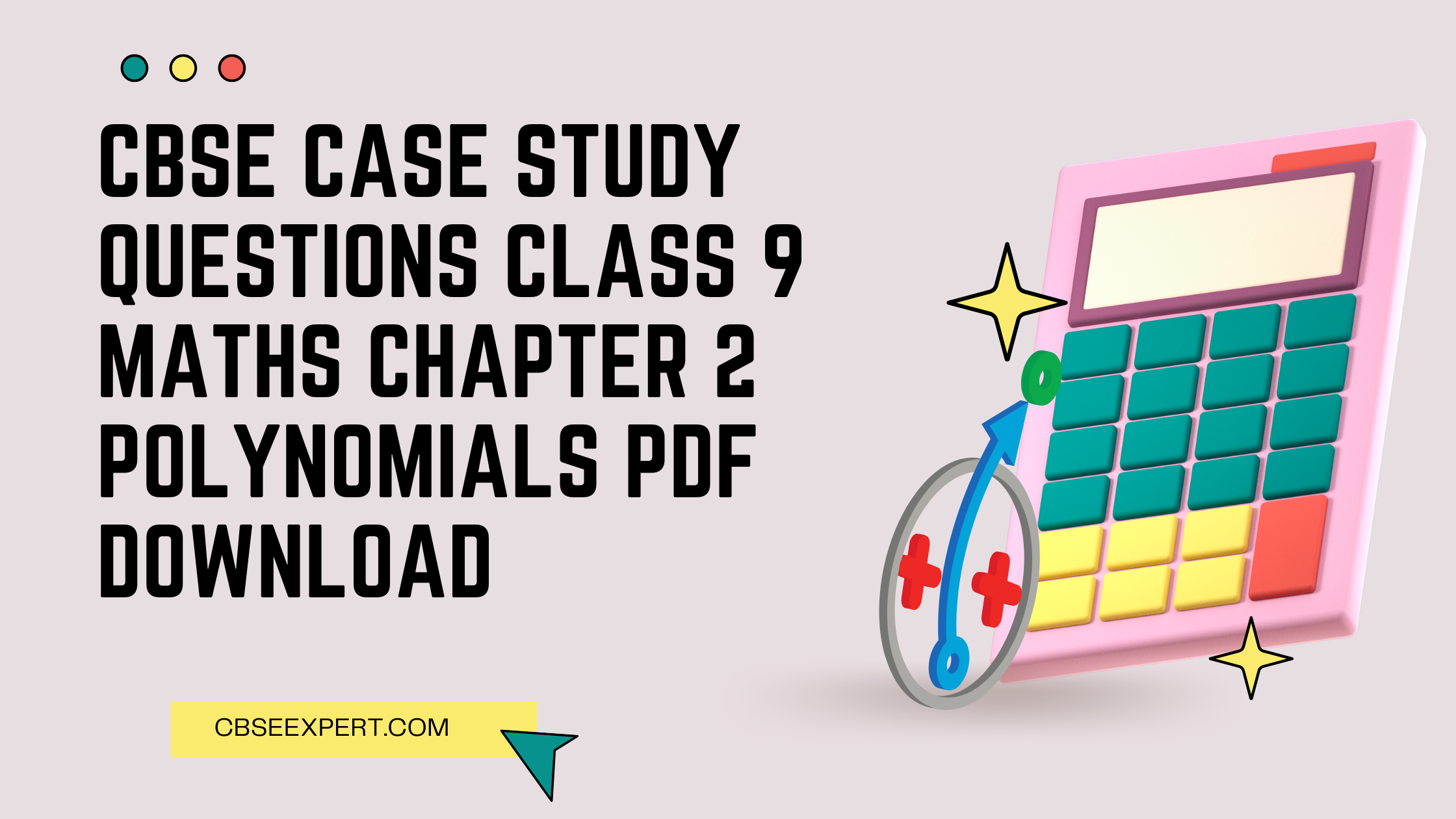
CBSE Case Study Questions Class 9 Maths Chapter 2 Polynomials PDF Download
CBSE Case Study Questions Class 9 Maths Chapter 2 Polynomials PDF Download are very important to solve for your exam. Class 9 Maths Chapter 2 Case Study Questions have been prepared for the latest exam pattern. You can check your knowledge by solving Case Study Questions Class 9 Maths Chapter 2 Polynomials

- Checkout: Class 9 Science Case Study Questions
- Checkout: Class 9 Maths Case Study Questions
Polynomials Case Study Questions With Answers
Case study questions class 9 maths chapter 2.
Case Study/Passage-Based Questions
Case Study 1. Ankur and Ranjan start a new business together. The amount invested by both partners together is given by the polynomial p(x) = 4x 2 + 12x + 5, which is the product of their individual shares.
Coefficient of x 2 in the given polynomial is (a) 2 (b) 3 (c) 4 (d) 12
Answer: (c) 4
Total amount invested by both, if x = 1000 is (a) 301506 (b)370561 (c) 4012005 (d)490621
Answer: (c) 4012005
The shares of Ankur and Ranjan invested individually are (a) (2x + 1),(2x + 5)(b) (2x + 3),(x + 1) (c) (x + 1),(x + 3) (d) None of these
Answer: (a) (2x + 1),(2x + 5)
Name the polynomial of amounts invested by each partner. (a) Cubic (b) Quadratic (c) Linear (d) None of these
Answer: (c) Linear
Find the value of x, if the total amount invested is equal to 0. (a) –1/2 (b) –5/2 (c) Both (a) and (b) (d) None of these
Answer: (c) Both (a) and (b)
Case Study 2. One day, the principal of a particular school visited the classroom. The class teacher was teaching the concept of a polynomial to students. He was very much impressed by her way of teaching. To check, whether the students also understand the concept taught by her or not, he asked various questions to students. Some of them are given below. Answer them
Which one of the following is not a polynomial? (a) 4x 2 + 2x – 1 (b) y+3/y (c) x 3 – 1 (d) y 2 + 5y + 1
Answer: (b) y+3/y
The polynomial of the type ax 2 + bx + c, a = 0 is called (a) Linear polynomial (b) Quadratic polynomial (c) Cubic polynomial (d) Biquadratic polynomial
Answer: (a) Linear polynomial
The value of k, if (x – 1) is a factor of 4x 3 + 3x 2 – 4x + k, is (a) 1 (b) –2 (c) –3 (d) 3
Answer: (c) –3
If x + 2 is the factor of x 3 – 2ax 2 + 16, then value of a is (a) –7 (b) 1 (c) –1 (d) 7
Answer: (b) 1
The number of zeroes of the polynomial x 2 + 4x + 2 is (a) 1 (b) 2 (c) 3 (d) 4
Answer: (b) 2
Case Study 3. Amit and Rahul are friends who love collecting stamps. They decide to start a stamp collection club and contribute funds to purchase new stamps. They both invest a certain amount of money in the club. Let’s represent Amit’s investment by the polynomial A(x) = 3x^2 + 2x + 1 and Rahul’s investment by the polynomial R(x) = 2x^2 – 5x + 3. The sum of their investments is represented by the polynomial S(x), which is the sum of A(x) and R(x).
Q1. What is the coefficient of x^2 in Amit’s investment polynomial A(x)? (a) 3 (b) 2 (c) 1 (d) 0
Answer: (a) 3
Q2. What is the constant term in Rahul’s investment polynomial R(x)? (a) 2 (b) -5 (c) 3 (d) 0
Answer: (c) 6
Q3. What is the degree of the polynomial S(x), representing the sum of their investments? (a) 4 (b) 3 (c) 2 (d) 1
Answer: (c) 2
Q4. What is the coefficient of x in the polynomial S(x)? (a) 7 (b) -3 (c) 0 (d) 5
Answer: (b) -3
Q5. What is the sum of their investments, represented by the polynomial S(x)? (a) 5x^2 + 7x + 4 (b) 5x^2 – 3x + 4 (c) 5x^2 – 3x + 5 (d) 5x^2 + 7x + 5
Answer: (b) 5x^2 – 3x + 4
Case Study 4. A school is organizing a fundraising event to support a local charity. The students are divided into three groups: Group A, Group B, and Group C. Each group is responsible for collecting donations from different areas of the town.
Group A consists of 30 students and each student is expected to collect ‘x’ amount of money. The polynomial representing the total amount collected by Group A is given as A(x) = 2x^2 + 5x + 10.
Group B consists of 20 students and each student is expected to collect ‘y’ amount of money. The polynomial representing the total amount collected by Group B is given as B(y) = 3y^2 – 4y + 7.
Group C consists of 40 students and each student is expected to collect ‘z’ amount of money. The polynomial representing the total amount collected by Group C is given as C(z) = 4z^2 + 3z – 2.
Q1. What is the coefficient of x in the polynomial A(x)? (a) 2 (b) 5 (c) 10 (d) 0
Answer: (b) 5
Q2. What is the degree of the polynomial B(y)? (a) 2 (b) 3 (c) 4 (d) 1
Answer: (b) 3
Q3. What is the constant term in the polynomial C(z)? (a) 4 (b) 3 (c) -2 (d) 0
Answer: (c) -2
Q4. What is the sum of the coefficients of the polynomial A(x)? (a) 2 (b) 5 (c) 10 (d) 17
Answer: (c) 10
Q5. What is the total number of students in all three groups combined? (a) 30 (b) 20 (c) 40 (d) 90
Answer: (c) 40
Hope the information shed above regarding Case Study and Passage Based Questions for Case Study Questions Class 9 Maths Chapter 2 Polynomials with Answers Pdf free download has been useful to an extent. If you have any other queries about CBSE Class 9 Maths Polynomials Case Study and Passage-Based Questions with Answers, feel free to comment below so that we can revert back to us at the earliest possible By Team Study Rate
Leave a Comment Cancel reply
Save my name, email, and website in this browser for the next time I comment.
Download India's best Exam Preparation App Now.
Key Features
- Revision Notes
- Important Questions
- Previous Years Questions
- Case-Based Questions
- Assertion and Reason Questions
No thanks, I’m not interested!

IMAGES
VIDEO
COMMENTS
Answer: (c) 6 meters. Q5. The lengths of the altitudes corresponding to the sides of 8 meters and 12 meters are: (a) 4 meters and 6 meters. (b) 6 meters and 8 meters. (c) 8 meters and 10 meters. (d) 10 meters and 12 meters. Answer: (a) 4 meters and 6 meters. Case Study 2: A group of students is studying Heron's Formula for finding the area of ...
Here we are providing case study questions for Class 9 Maths Chapter 12 Herons Formula. Students are suggested to solve the questions by themselves first and then check the answers. This will help students to check their grasp on this particular chapter Triangles. Case Study Questions:
Download Class 9 Maths Case Study Questions to prepare for the upcoming CBSE Class 9 Exams 2023-24. These Case Study and Passage Based questions are published by the experts of CBSE Experts for the students of CBSE Class 9 so that they can score 100% in Exams. Case study questions play a pivotal role in enhancing students' problem-solving skills.
Class 9 Mathematics Case study question 2. Read the Source/Text given below and answer any four questions: Maths teacher draws a straight line AB shown on the blackboard as per the following figure. Now he told Raju to draw another line CD as in the figure. The teacher told Ajay to mark ∠ AOD as 2z.
Introduction of CBSE Case Study Questions for Class 9 Maths - Pdf in English is available as part of our Class 9 preparation & CBSE Case Study Questions for Class 9 Maths - Pdf in Hindi for Class 9 courses. Download more important topics, notes, lectures and mock test series for Class 9 Exam by signing up for free.
CBSE Class 9 Maths Question Bank on Case Studies given in this article can be very helpful in understanding the new format of questions. Each question has five sub-questions, each followed by four options and one correct answer. Students can easily download these questions in PDF format and refer to them for exam preparation. Case Study Questions.
Case Study Questions for Chapter 15 Probability. The above Case studies for Class 9 Mathematics will help you to boost your scores as Case Study questions have been coming in your examinations. These CBSE Class 9 Maths Case Studies have been developed by experienced teachers of schools.studyrate.in for benefit of Class 10 students.
Important Questions & Answers For Class 9 Maths Chapter 12. Q.1: Find the area of a triangle whose two sides are 18 cm and 10 cm and the perimeter is 42cm. Solution: Assume that the third side of the triangle to be "x". Now, the three sides of the triangle are 18 cm, 10 cm, and "x" cm. It is given that the perimeter of the triangle = 42cm.
Here, we have provided case-based/passage-based questions for Class 9 Maths Chapter 2 Polynomials. Case Study/Passage Based Questions. Ankur and Ranjan start a new business together. The amount invested by both partners together is given by the polynomial p (x) = 4x 2 + 12x + 5, which is the product of their individual shares.
The semi perimeter of the each triangular shape = (28+9+35)/2 cm = 36 cm. By using Heron's formula, The area of each triangular shape will be. = 36√6 cm 2 = 88.2 cm 2. Now, the total area of 16 tiles = 16×88.2 cm 2 = 1411.2 cm 2. It is given that the polishing cost of tiles = 50 paise/cm 2.
The Class 9 Maths Chapter 12 revision notes are suitable for students who want to-the-point study resources to brush up on their concepts. Being expert-curated, our Class 9 Maths Chapter 12 notes are completely factually correct and contain an accurate description of each chapter concept.
Heron's Formula Class 9 Extra Questions Very Short Answer Type. Question 1. Find the area of an equilateral triangle having side 6 cm. Solutioin: Area of an equilateral triangle = 3√ 4 × (side) 2 = 3√ 4 × 6 × 6 = 9√3 cm 2. Question 2. If the perimeter of an equilateral triangle is 90 m, then find its area. Solutioin:
Heron's Formula is given in Chapter 12 of Class 9 Maths which is a part of Mensuration. Heron's formula helps students to find the area of a triangle in which the measure of all three sides is given. Students will understand the concept of Heron's formula by solving important questions given online.
Here you will get complete NCERT Solutions for Class 9 Maths Chapter 12 all exercises Exercise in one place. These solutions are prepared by the subject experts and as per the latest NCERT syllabus and guidelines. CBSE Class 9 Students who wish to score good marks in the maths exam must practice these questions regularly.
Ex 12.1 Class 9 Maths Question 6. An isosceles triangle has perimeter 30 cm and each of the equal sides is 12 cm. Find the area of the triangle. Solution: Let the sides of an isosceles triangle be. a = 12cm, b = 12cm,c = x cm. Since, perimeter of the triangle = 30 cm. ∴ 12cm + 12cm + x cm = 30 cm. ⇒ x = (30 - 24) = 6.
In this post I have provided CBSE Class 9 Maths Case Study Based Questions With Solution. These questions are very important for those students who are ... Chapter-15(Waves) CBSE Class 12 Physics Notes Menu Toggle. Chapter-1(Electric Charges And Fields) Chapter-2(Electrostatic Potential and Capacitance) Chapter-3(Current Electricity)
5 months ago February 4, 2024 Physics Gurukul Leave a Comment on Case Study Questions for Class 9 Maths Chapter 12 Herons Formula. ... 2024 Physics Gurukul Leave a Comment on Case Study Questions for Class 9 Maths Chapter 9 Areas of Parallelograms and Triangles.
Chapter-wise NCERT Solutions for Class 9 Maths Chapter 12 Herons Formula Ex 12.2 solved by Expert Teachers as per NCERT (CBSE) Book guidelines. CBSE Class 9 Maths Herons Formula Exercise Questions with Solutions to help you to revise complete Syllabus and Score More marks.
Semi-perimeter is denoted by 's' in Heron's formula, which is Area= √s (s-a) (s-b) (s-c) 's' stands for semi-perimeter, which can be calculated by the given formula: s = a+b+c/2, where a, b and c are the sides of the triangle of which the area has to be calculated. Access free NCERT Solutions for Class 9 Maths Chapter 10, Heron's ...
NCERT Solutions For Class 9 Maths Chapter 12; NCERT Solutions For Class 9 Maths Chapter 13; ... In the case of equilateral and isosceles triangles, if the lengths of the sides of triangles are given, we use Pythagoras' theorem in order to find the height of a triangle. ... Visit BYJU'S for all Maths related queries and study materials. Your ...
5. The prime factorization of 13915 is. a) 5 × 11 3 × 13 2. b) 5 × 11 3 × 23 2. c) 5 × 11 2 × 23. d) 5 × 11 2 × 13 2. Show Answer. Case Study 2: Srikanth has made a project on real numbers, where he finely explained the applicability of exponential laws and divisibility conditions on real numbers. He also included some assessment ...
EXERCISE 12.1 CLASS 9 MATHS CHAPTER 12 - HERON'S FORMULA: NCERT Solutions for Class 9 Maths Chapter 12 Heron's Formula Ex 12.1 are given here for free which the students can download and clear their doubts instantly. ... In other words, NCERT Solutions is one of the best guides for your study needs. Relevant topics are presented in an easy-to ...
Case Study Questions Class 9 Maths Chapter 2. Case Study/Passage-Based Questions. Case Study 1. Ankur and Ranjan start a new business together. The amount invested by both partners together is given by the polynomial p (x) = 4x 2 + 12x + 5, which is the product of their individual shares. Coefficient of x2 in the given polynomial is.